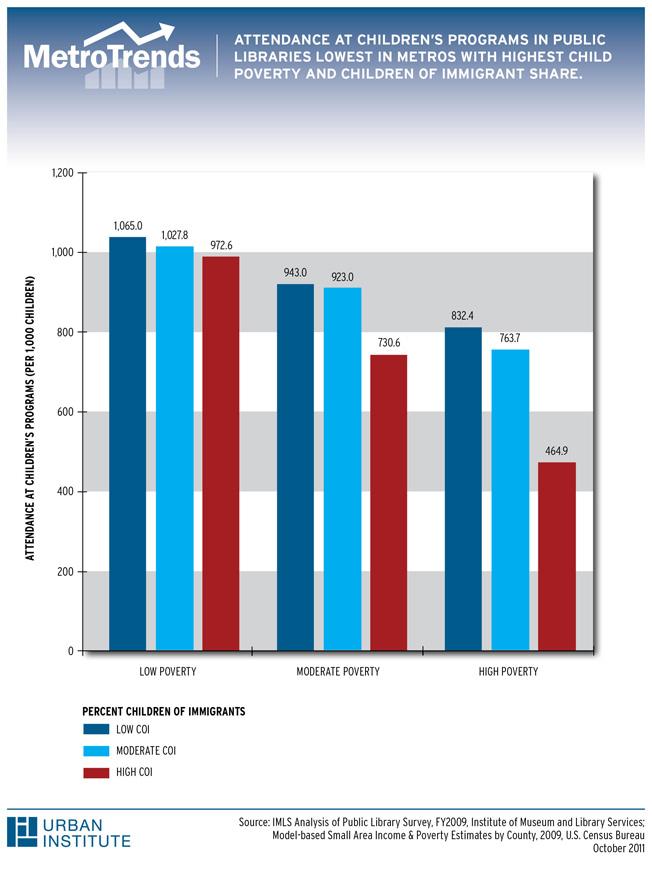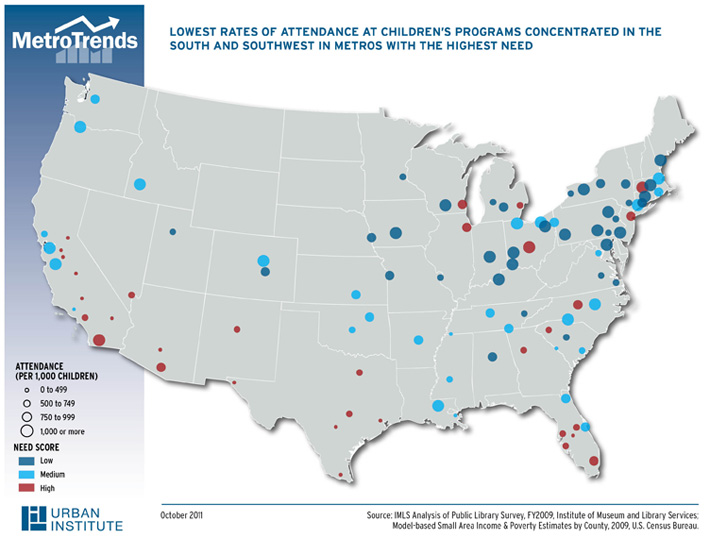
|
|
Libraries Children's Services at Public Libraries: A Port in the StormAs policymakers search for solutions to improve child outcomes during a time of constrained budgets, one group of institutions is often overlooked. As community anchor institutions, public libraries increase children's access to books and computers, and provide meaningful learning opportunities. These functions are particularly critical for children from high-need families who often fall behind in school. Most children living in poverty have few or no books at home, as well as limited access to the Internet. They also have inadequate access to print materials in their schools and communities. Among poor children, those with immigrant parents often face even greater challenges because many come from "language isolated" households, in which no one over the age of 14 speaks only English or speaks English well. From 2005 to 2009, utilization of public library children's services, ranging from storybook hours for young children to homework help for teens, increased in the top 100 metropolitan areas. Per capita attendance at children's programs in public libraries rose from 727 (per 1,000 children) in 2005 to 818 in 2009, a five-year increase of 12.5 percent. Circulation of children's materials increased as well, from 10.7 books per child in 2005 to 12.1 books per child in 2009, a total of 13.1 percent. Unfortunately, this same time period also saw an increase in the number of high-need children. The percent of children living in poverty rose from 17.3 percent in 2005 to 18.6 percent in 2009, with a particularly steep year-to-year increase from 2008 to 2009 of 10.1 percent. The number of children with immigrant parents also increased substantially. These demographic changes pose challenges for libraries. Utilization of children's services at public libraries varies considerably across the 100 metro areas, something that is masked in the aggregate state and national statistics. And these disparities are highly related to both child poverty rates and percentage of children in immigrant families. The highest attendance rates (1,065 per 1,000 children)1 are in the seven metro areas with the lowest levels of both child poverty and children of immigrants. In stark contrast, the lowest attendance (464.9) is in the nine metro areas with the highest levels of both poverty and children of immigrants. For example, McAllen, a metro with high child poverty and high percentage of children of immigrants, has the 10th lowest number of children's programs offered (13.2 per 1,000 children), the 3rd lowest rate of attendance at these programs (312.6 per 1,000 children) and the lowest level of circulation of children's materials – only 1.6 books per child. In metros with low child poverty and low percentage of children of immigrants, there is a different picture. In comparison, the Madison (WI) metro area has the 8th highest number of children's programs offered (55 per 1,000 children), the 2nd highest rate of attendance (1722.8 per 1,000 children), and the 3rd highest circulation (29.8 per child). It is important to also note the extreme discrepancies in funding between these areas: McAllen ranked 98th for public library revenue ($14.06 per capita), whereas Madison was 21st ($49.10 per capita). These trends have a strong regional element as well. The lowest rates of utilization of children's services at public libraries occurred in the South and Southwest, ranging from California through Texas to Florida. In addition, 70 percent of high-need2 metros fall within these regions. These metros also had some of the lowest circulation rates, an average of 4.9 books per child. With rapidly changing demographics in the US population and increasing child poverty rates, many metropolitan areas face substantial challenges in meeting the goals of educational initiatives—like Race To The Top and the Early Learning Challenge—and narrowing persistent achievement gaps. The public library is the one place that offers all children, rich or poor, equal access to vital low-barrier educational support services in both remote rural communities and major cities across the United States. Consequently, investment in public libraries for the delivery of children's services is a good strategic investment, even in today's tough budget climate. However, part of the challenge is that funding for children's programs, which is drawn primarily from state and local governments, is unevenly distributed. This results in regional disparities in resource availability, especially in high-need metro areas. These findings highlight opportunities to deploy targeted investments and outreach strategies for public libraries to communicate more effectively with these families and to connect them to the resources available. 1In areas with attendance rates (per 1,000 children) in excess of 1,000, this indicates that there are at least some children who visit the library to attend more than one program. In contrast, in areas with attendance rates below 500, fewer than half of the children have visited a library to attend a children?s program. 2Metro areas were ranked and classified as high-, moderate-, or low-need, based on the level of child poverty (POV) and children of immigrants (COI), as illustrated by the 9 groups in the bar chart. High Need: High POV + High COI, High POV + Moderate COI, Moderate POV + High COI; Moderate Need: Moderate POV + Moderate COI, High POV + Low COI, Low POV + High COI; and Low Need: Low POV + Low COI, Low POV + Moderate COI, Moderate POV + Low COI |
Experts Feedback
Send us your comments to help further the discussion. Share
Commentaries
|







 Deanne W. Swan
Deanne W. Swan Carlos A. Manjarrez
Carlos A. Manjarrez